HP’s EliteBook 6 G1q redefines enterprise mobility for the hybrid workforce, combining Snapdragon-powered AI performance with robust security and seamless remote management. Designed for professionals who need desktop-grade power in a portable form, this 14-inch Copilot+ PC delivers next-gen AI capabilities with impressive power efficiency. At 3.17 pounds and 17.9mm thick, it’s light enough to toss in a backpack without feeling like dead weight, yet solid enough to inspire confidence on the road.
The EliteBook 6 G1q sits near the top of HP’s business notebook lineup, delivering more battery efficiency than traditional Intel-based models in the EliteBook family. Powered by Qualcomm’s Snapdragon X platform, the system offers configurations ranging from the Snapdragon X1-26-100 and mid-tier X1P-42-100 (Snapdragon X Plus) to the flagship X1E-78-100 (Snapdragon X Elite).
Typing on the keyboard is surprisingly comfortable, with quiet, snappy keys that make long stretches of typing much less tiring. The trackpad is smooth and responsive, handling gestures effortlessly, so you rarely need a mouse. The 14-inch display is easy on the eyes, with crisp text and consistent brightness, making hours of spreadsheets, emails, or reports much easier to endure.
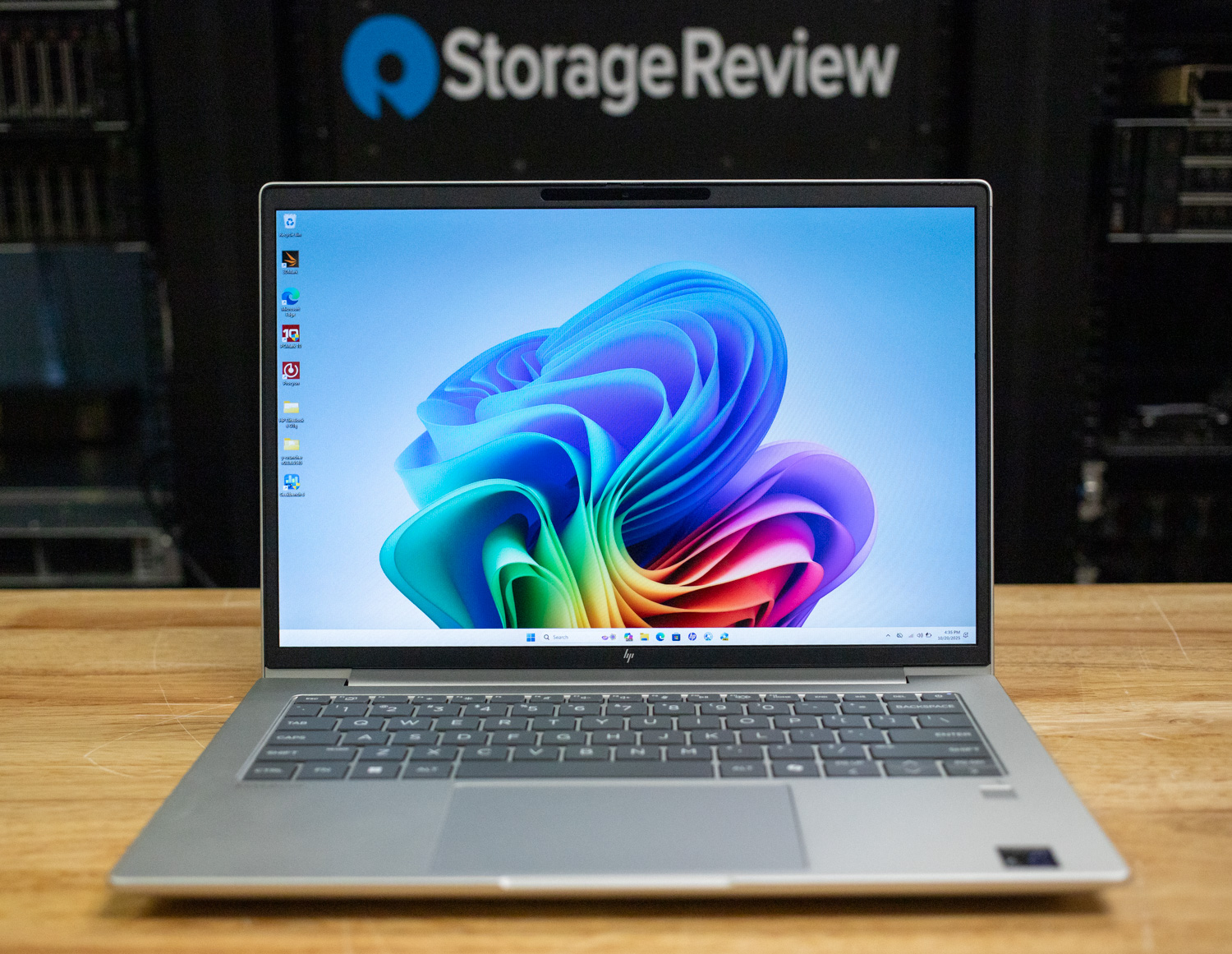
Pricing for the EliteBook 6 G1q starts around $1,319, with our config priced at $3,100 on the HP store.
Configuration and Specifications
| Model | EliteBook 6 G1q 14-inch Notebook |
| Processor Family | Snapdragon X Elite, X Plus, or X processor |
| Available Processors | Snapdragon X Elite X1E-78-100 (up to 3.4 GHz, 12 cores)
Snapdragon X Plus X1P-42-100 (up to 3.2 GHz, eight cores) Snapdragon X X1-26-100 (up to 2.97 GHz, eight cores) |
| Neural Processing Unit (NPU) | Qualcomm Hexagon™ NPU (45 TOPS) |
| Graphics | Integrated Qualcomm Adreno™ GPU (Support DX12 and HDMI 2.1) |
| Operating Systems | Windows 11 Pro / Home / Home Single Language |
| Maximum Memory | 64 GB LPDDR5X-8533 MT/s (Soldered) |
| Internal Storage | 256 GB up to 1 TB PCIe NVMe M.2 SSD |
| Display Size | 35.6 cm (14″) diagonal |
| Display Options | WUXGA (1920 x 1200) IPS, 400 nits, 100% sRGB
WUXGA (1920 x 1200) IPS, 800 nits, HP Sure View 5 Privacy Screen 2.5K (2560 x 1600) IPS, 120 Hz, 400 nits, 100% Adobe RGB/DCI-P3 |
| Ports and Connectors | 2 x USB Type-C 40Gbps (Power Delivery, DisplayPort 1.4)
1 x HDMI 2.1 1 x stereo headphone/microphone combo jack 1 x RJ45, 2 x USB Type-A 5Gbps |
| Wireless Communications | Qualcomm FastConnect 7800 Wi-Fi 7 (2×2) and Bluetooth 5.4
Optional Qualcomm Snapdragon X72 5G Solution |
| Audio | Audio by Poly Studio, dual stereo speakers, dual array microphones |
| Camera | 1080p FHD camera, 5 MP IR camera (select models) |
| Battery Type & Power | HP Long Life 3-cell, 56 Wh or 48 Wh Li-ion polymer; 65W USB Type-C adapter |
| Max Battery Life | Up to 24 hours and 45 minutes |
| Starting Weight | Starting at 1.44 kg (3.17 lb) |
| Security Features | HP Sure Click, HP Sure Sense, TPM 2.0, Fingerprint sensor (select models) |
| Sustainable Impact | 50% recycled metal, 50% post-consumer recycled plastic in keycaps, EPEAT® Gold |
Build and Design
The HP EliteBook 6 G1q maintains HP’s professional design with a clean silver finish and rounded edges. It meets MIL-STD-810H durability standards for basic resistance to drops, vibration, and environmental stress. While it looks polished, physically it doesn’t meet expectations for a notebook at this price point. The chassis feels less rigid than other HP business models, with noticeable flex in the lid when adjusting the screen. The material finish resists fingerprints but comes off slightly plastic-like rather than the premium metal feel HP’s higher-end models deliver.
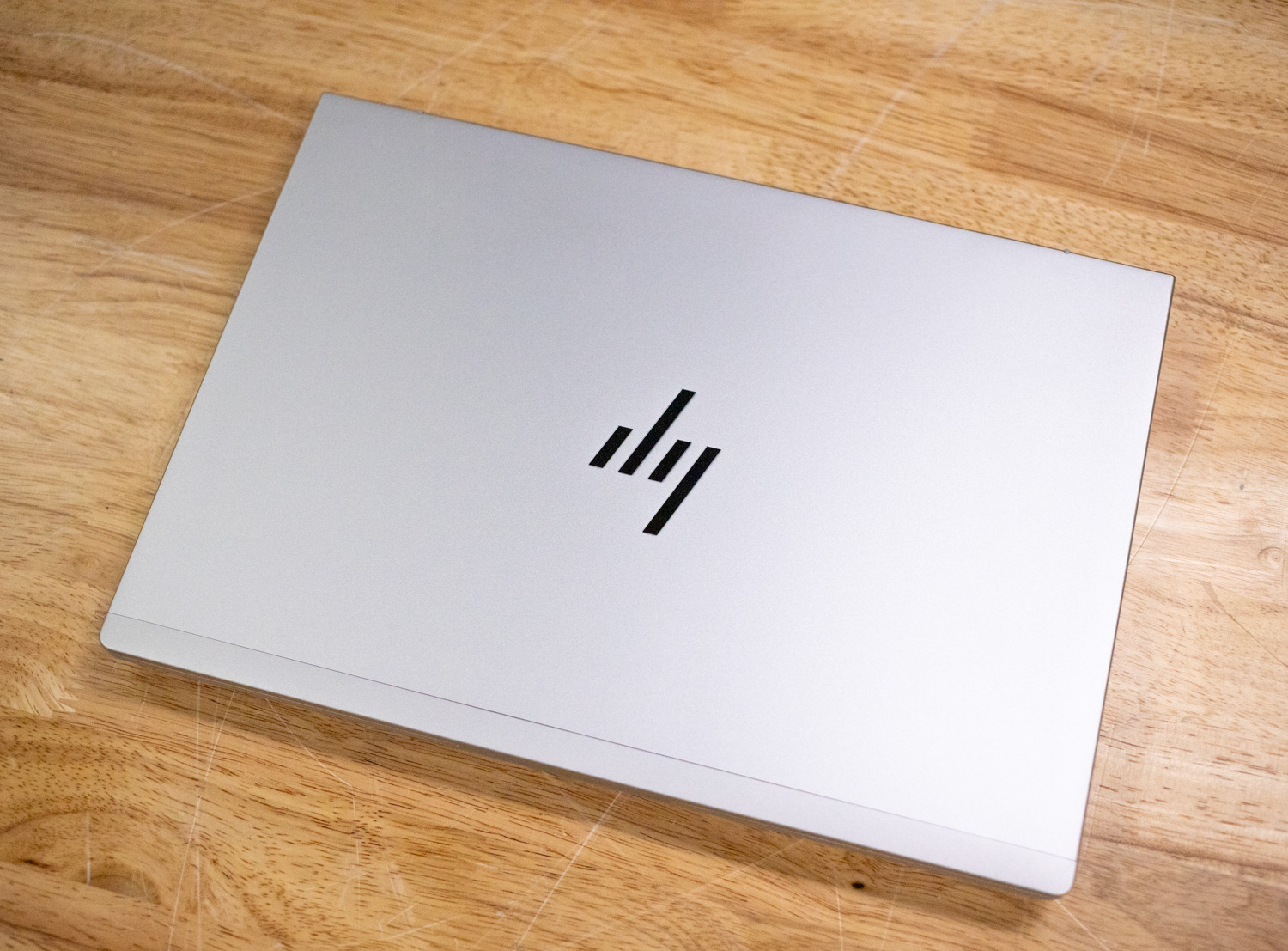
At 17.9 mm thick and 3.17 pounds, it remains highly portable, making it well-suited for professionals who travel frequently. The 14-inch 16:10 display sits in slim bezels, and the top-mounted webcam includes a physical privacy shutter, a standard feature for modern enterprise notebooks.
HP continues its focus on sustainability, using 50% recycled metal and 50% post-consumer recycled plastic in the chassis and keycaps. The device is EPEAT Gold certified, showing HP’s commitment to environmentally conscious design.
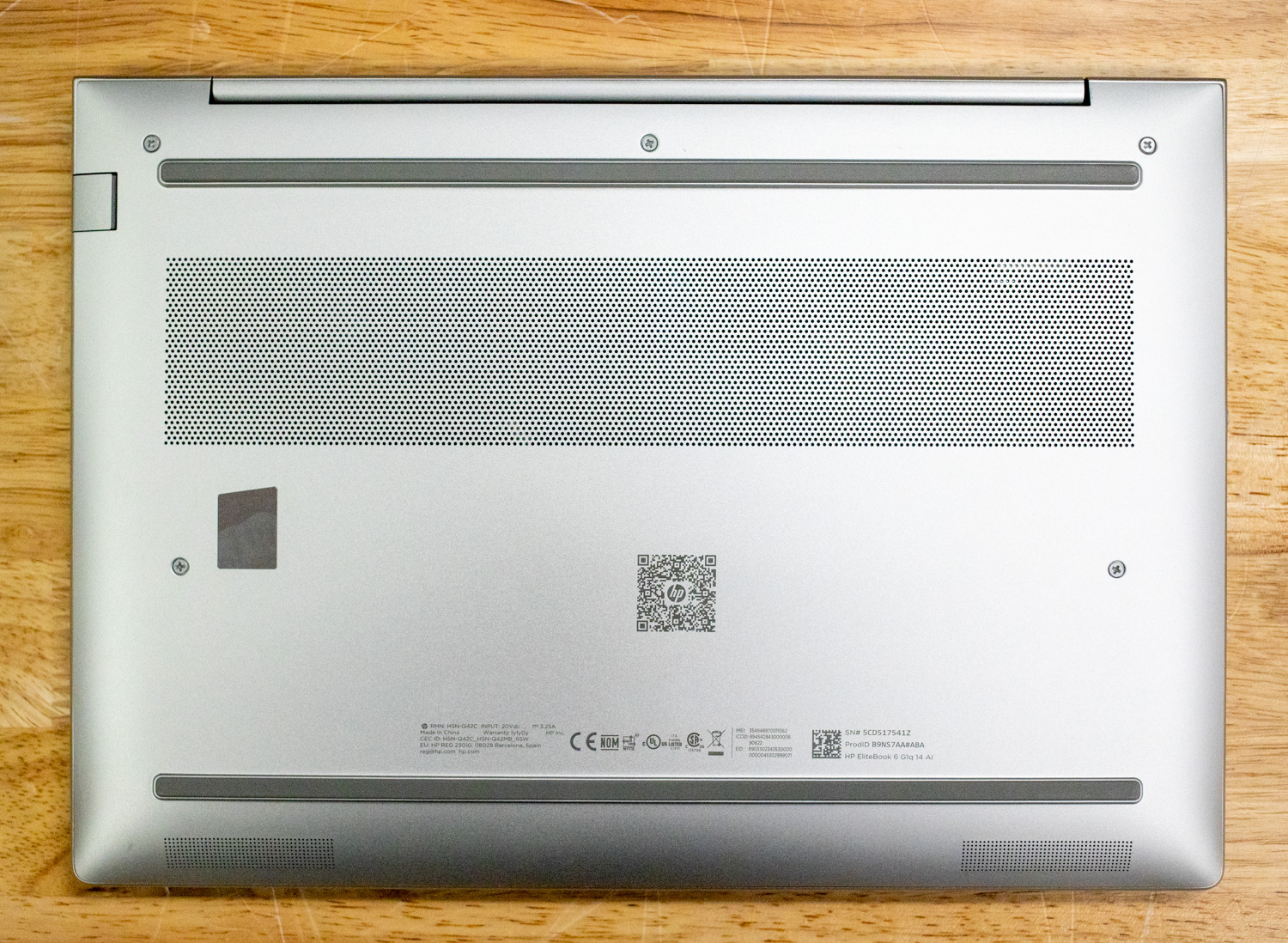
Connectivity and Ports
Connectivity options are comprehensive for a thin-and-light notebook. The EliteBook 6 G1q includes:
- 2x USB Type-C (40Gbps, Power Delivery, DisplayPort 1.4)
- 2x USB Type-A (5Gbps)
- HDMI 2.1
- RJ45 Ethernet
- 3.5mm headphone/mic combo jack
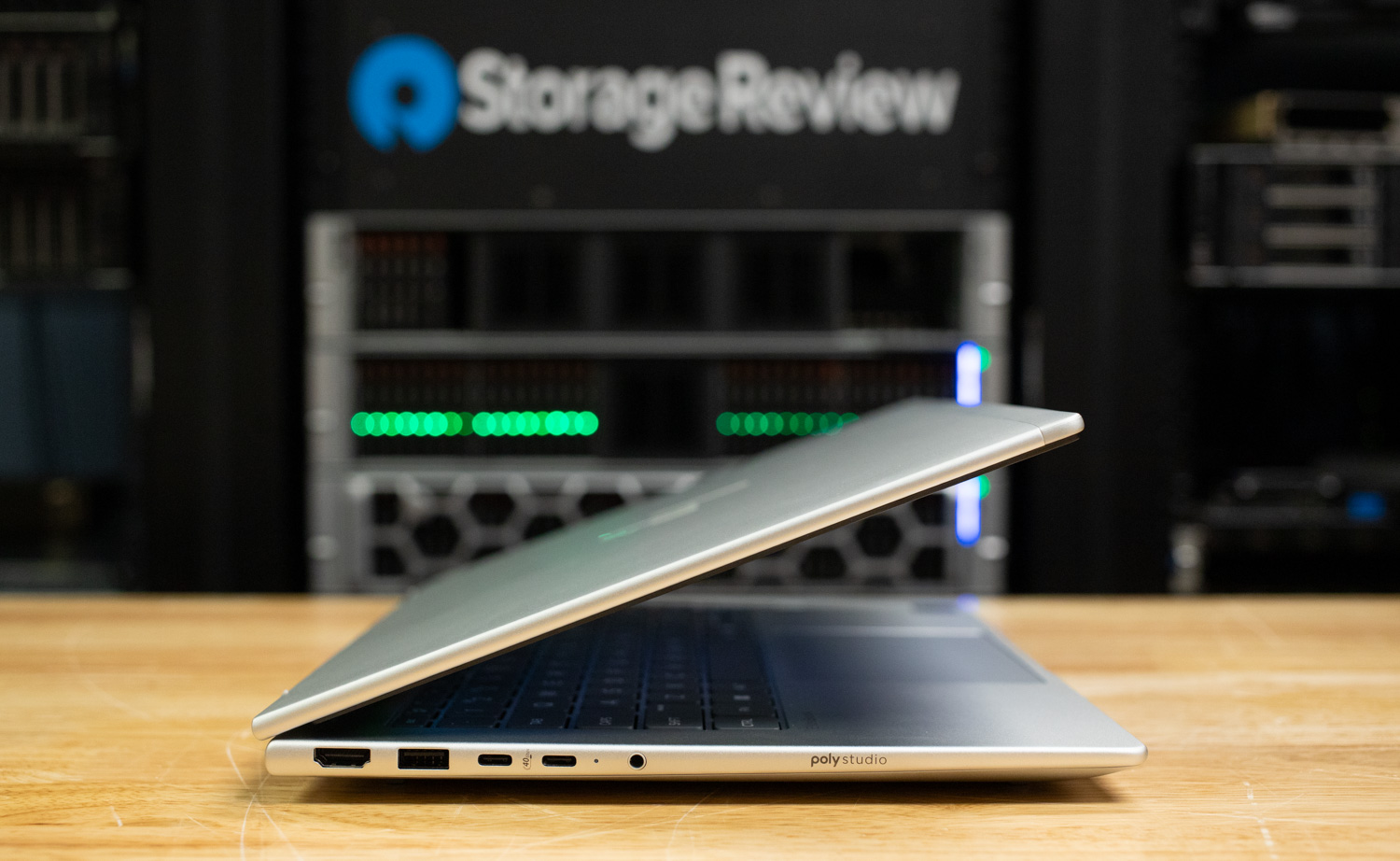
Wireless connectivity is managed by the Qualcomm FastConnect 7800, which supports Wi-Fi 7 (2×2) and Bluetooth 5.4, along with an optional Snapdragon X72 5G modem for mobile broadband.
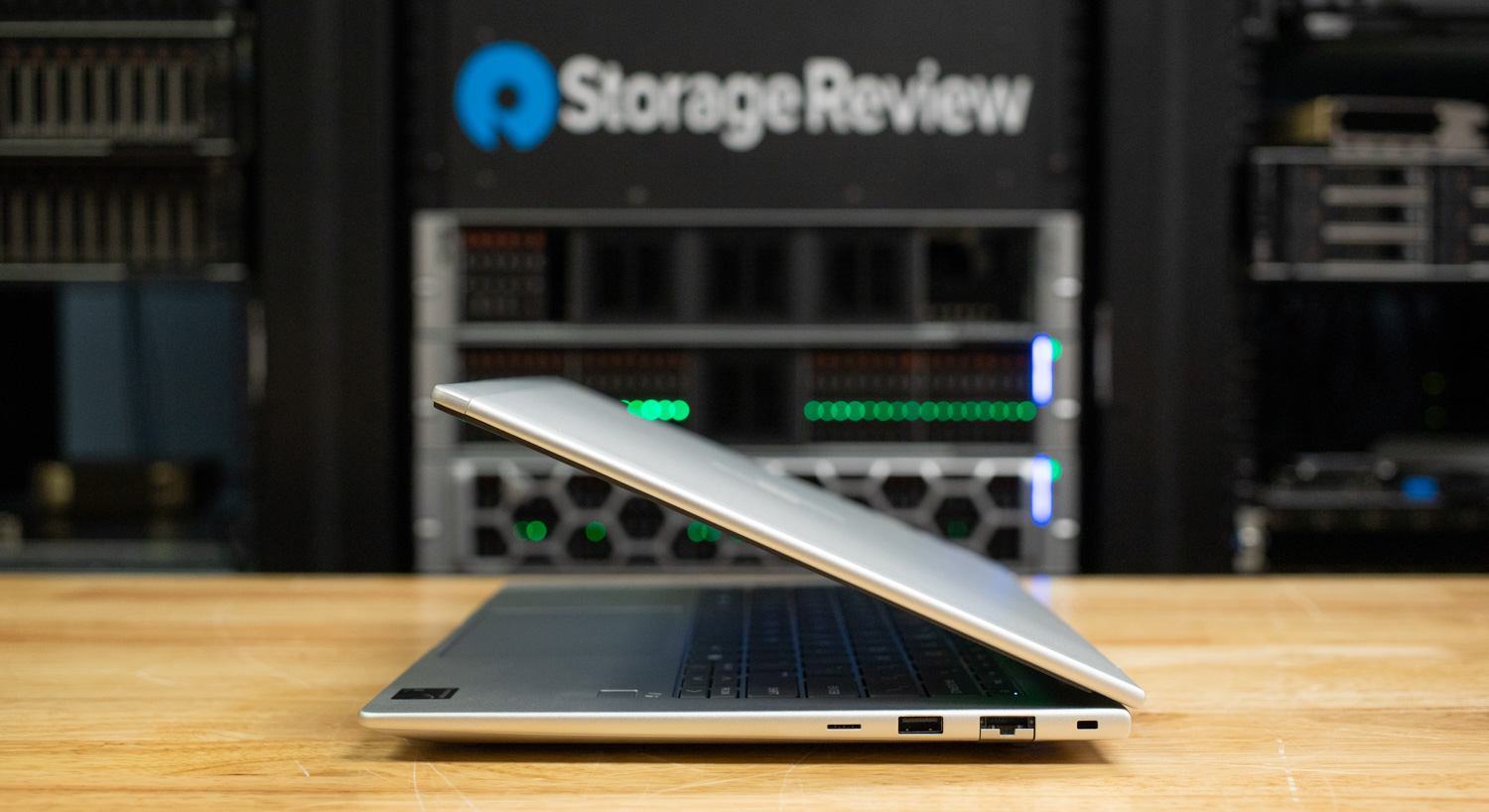
Audio, Camera, and Security
Built for hybrid business users, the EliteBook 6 G1q’s Poly Studio-tuned dual stereo speakers and dual-array microphones deliver clear, balanced audio that keeps voices crisp during meetings without distortion or echo. Camera options include a sharp 1080p FHD or upgraded 5MP IR sensor, both with a physical privacy shutter. The IR camera supports Windows Hello facial recognition, enabling fast, secure logins, eliminating the need to enter passwords.
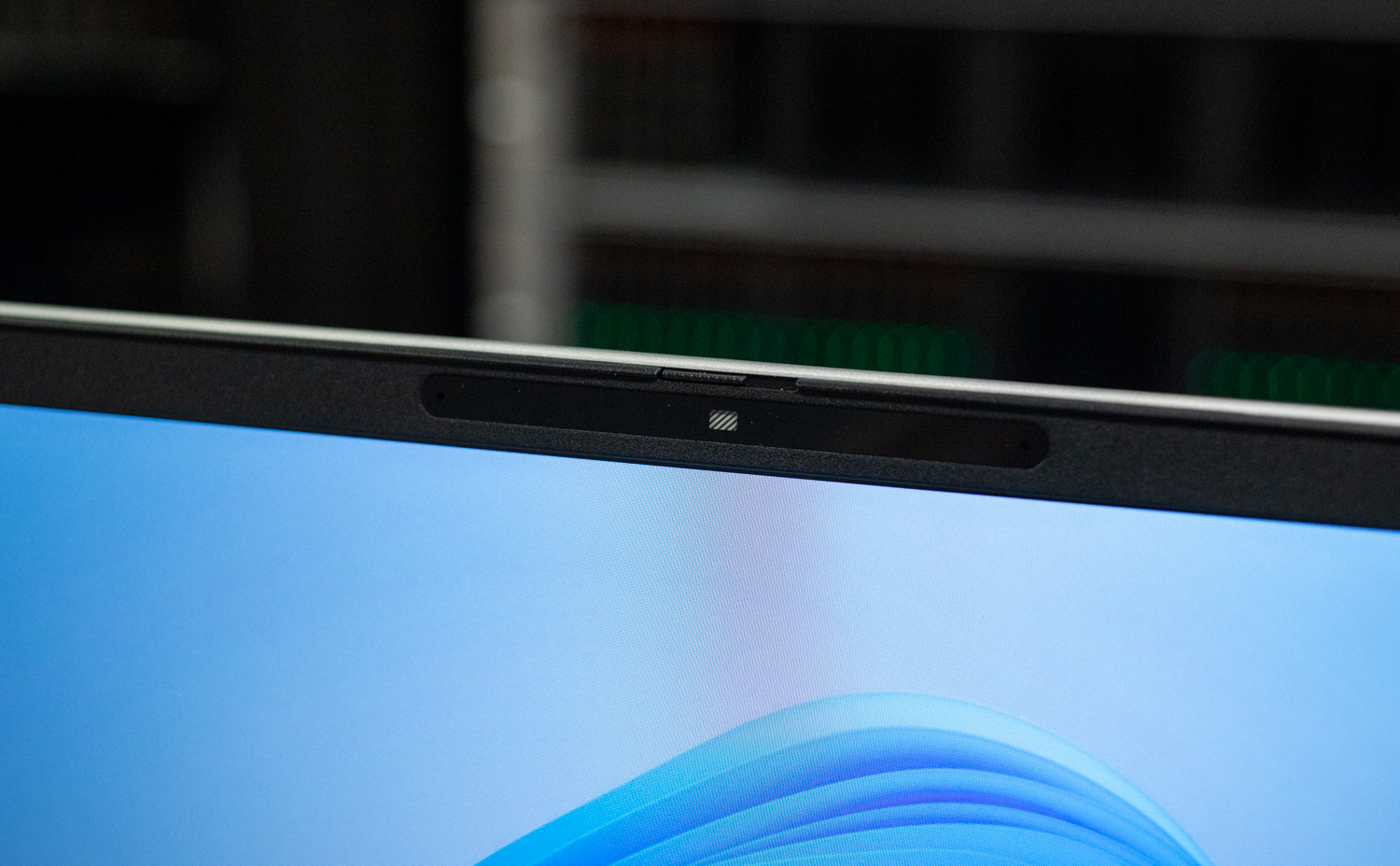
HP’s security suite goes beyond the basics. Sure Click opens web pages and Office files in isolated virtual containers, so even if a malicious site or attachment attempts to execute code, it’s prevented from accessing the rest of the system. Sure Sense uses AI-driven threat detection to spot and block new or unknown malware in real time. Hardware-level security is performed by TPM 2.0 and a built-in fingerprint reader. At the same time, Onlooker Detection uses the webcam to sense when someone’s peeking over your shoulder and automatically blurs the screen to protect sensitive content. For IT teams, HP Wolf Security enables remote monitoring, patching, and device management, keeping endpoints secure even outside the office.
Screen and Input Devices
The 14-inch display lineup offers flexibility for a range of professional needs. The base model features a WUXGA (1920×1200) IPS panel rated for 400 nits and 100% sRGB coverage. A Sure View 5 variant doubles brightness to 800 nits and adds HP’s built-in privacy filter. The top-tier configuration offers a 2.5K (2560×1600) IPS panel with a 120Hz refresh rate, 400 nits, and 100% Adobe RGB/DCI-P3 color support, ideal for visual professionals.
The 400-nit WUXGA display offers sharp text and consistent brightness across the panel. It’s well-suited for office and productivity tasks, though the color depth and contrast fall short of what creative professionals might expect. Viewing angles are good, and brightness holds up under indoor lighting, but outdoor visibility could be better under direct sunlight. The keyboard is comfortable for long typing sessions, providing quiet, responsive feedback and well-spaced keys typical of HP’s EliteBook line.
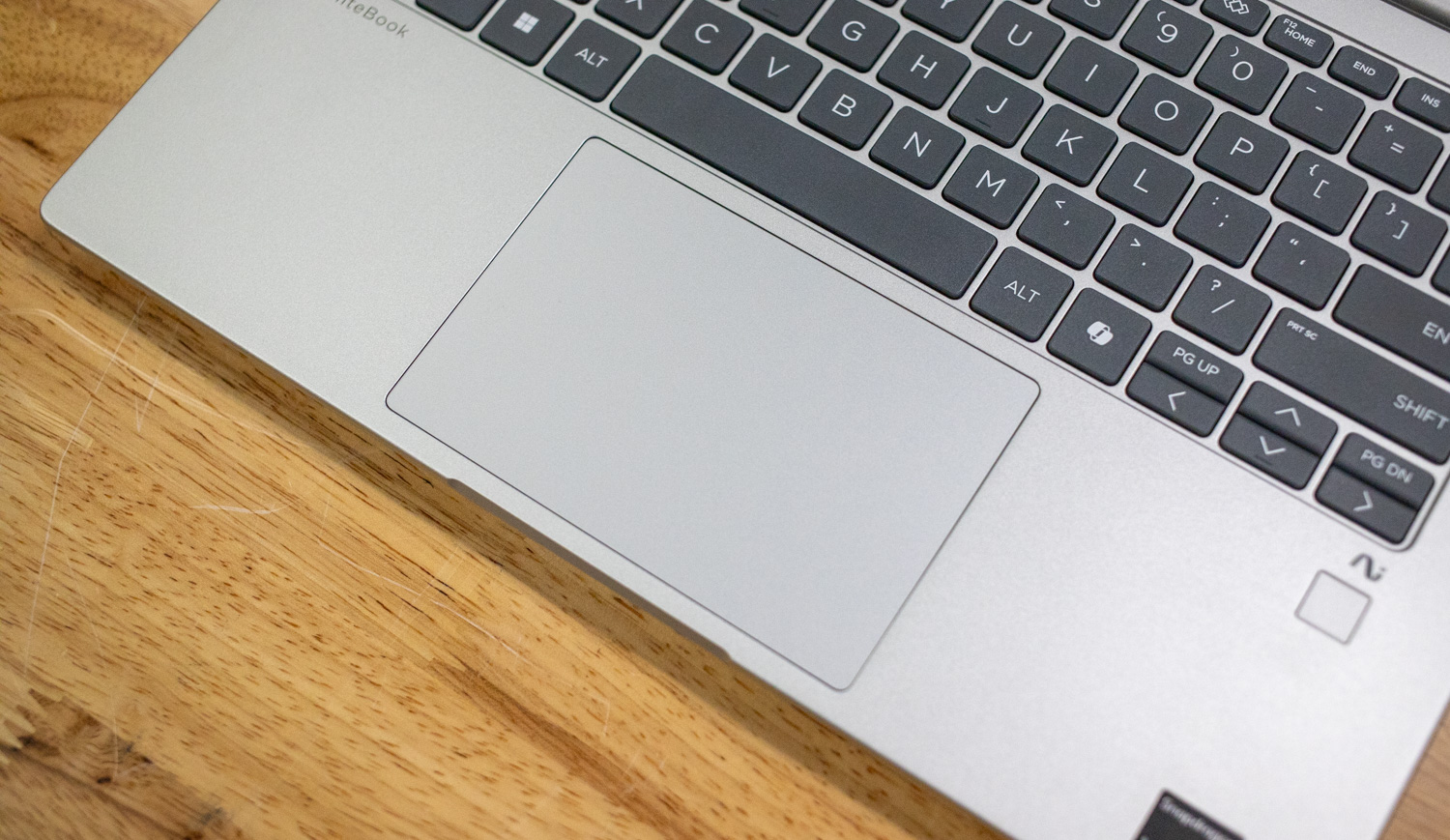
The touchpad is well-sized, offers excellent tactile feedback, is smooth and responsive, and ensures accurate gesture control with effective palm rejection.
Battery and Power
Battery life is another strong point for the EliteBook 6 G1q. HP offers both 48Wh and 56Wh battery options, rated for up to 24 hours and 45 minutes of use, depending on the configuration. The system supports fast charging via its 65W USB-C adapter, and the Snapdragon X platform’s efficiency keeps thermals low and fan noise minimal even under sustained workloads.
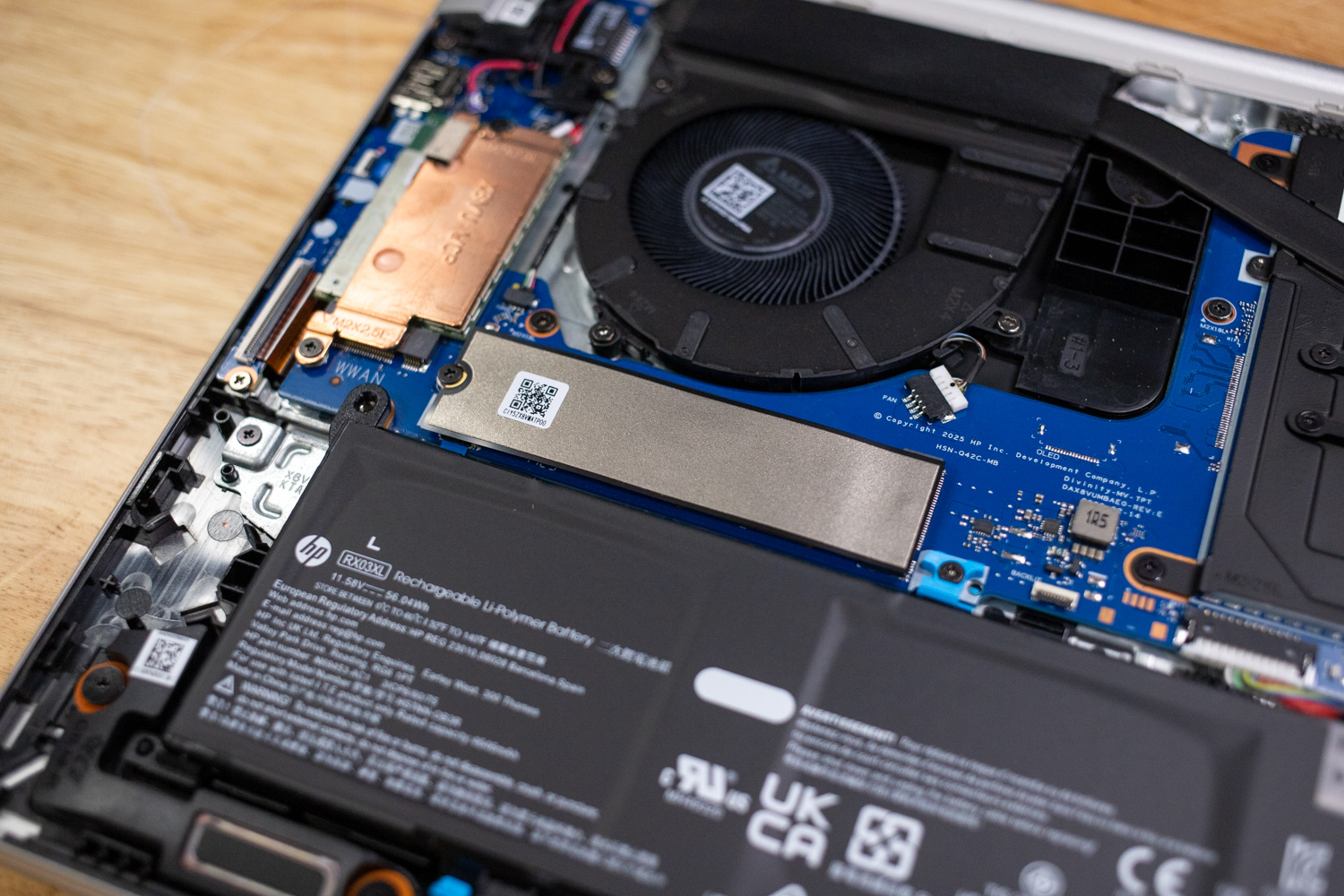
Upgradeability
The EliteBook 6 G1q’s design prioritizes efficiency over modularity. Memory is soldered to the motherboard, meaning the configuration you purchase is the one you’ll live with. Storage, however, is accessible and upgradeable. HP uses a standard M.2 PCIe Gen4 NVMe SSD, which can be replaced if needed. Accessing the internals requires removing four Phillips screws on the bottom panel. Once inside, users will find clean component organization but limited options for expansion. This setup aligns with HP’s recent design direction, favoring thinness and efficiency over serviceability.
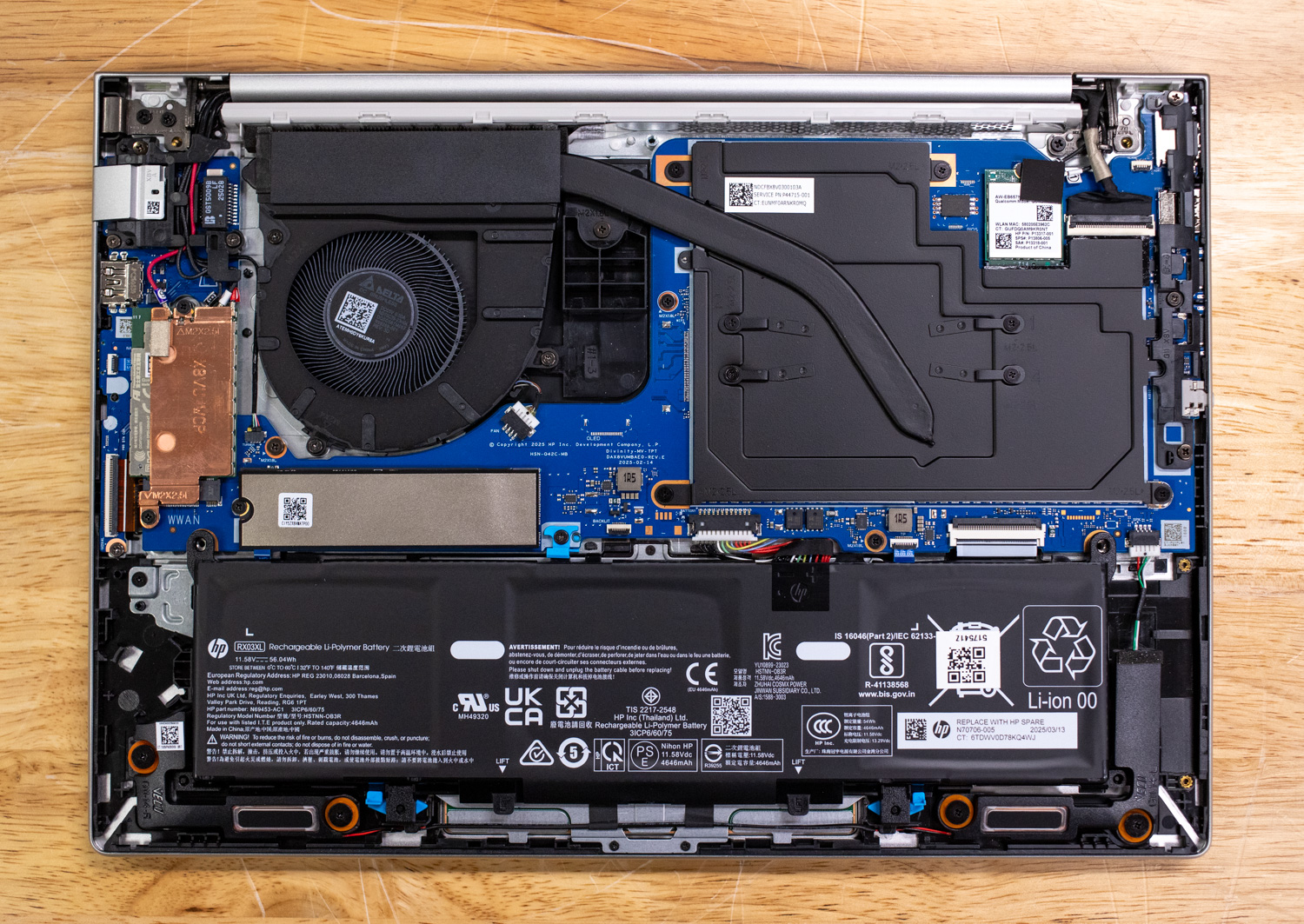
Performance Testing
The model tested here features the Snapdragon X Plus (X1P-42-100), clocked up to 3.2 GHz with eight cores and 6 MB L3 cache. The Qualcomm Adreno GPU handles graphics, while the Hexagon NPU delivers up to 45 TOPS of AI acceleration.
Our review unit is configured with 32GB of LPDDR5X-8488 MT/s memory (soldered) and a 500GB PCIe Gen4 NVMe SSD. The system is powered by a 56Wh HP Long Life Li-ion polymer battery, paired with a 65W USB-C power adapter.
- Processor: Snapdragon X Plus, Base/Turbo Clock up to 3.2GHz, eight cores/eight threads
- GPU: Qualcomm Adreno integrated GPU
- NPU: Hexagon NPU (45 TOPS)
- Memory: 32GB LPDDR5X-8488 MT/s (soldered)
- Storage: 500GB PCIe Gen4 NVMe SSD
- Battery: 56Wh HP Long Life Li-ion Polymer
Model comparisons
Geekbench
Geekbench 6 is a cross-platform benchmark that measures overall system performance. The Geekbench Browser allows you to compare any system.
In Geekbench 6.3.0, the HP EliteBook 6 G1q posted a 2,428 single-core, 11,408 multi-core, and 9,604 OpenCL GPU score, showing strong CPU consistency and balanced graphics output. The Dell Latitude 7455 trailed in CPU performance but led in GPU throughput, reaching 2,431/7,076 CPU and 20,545 GPU in Ultra Performance mode. The Latitude 7450 Ultralight landed in between with 2,407 / 9,922 CPU and 17,052 GPU. Overall, the EliteBook 6 G1q favors sustained multi-core efficiency, while Dell’s systems lean toward higher burst GPU performance.
| HP EliteBook 6 G1q | |||||||
|---|---|---|---|---|---|---|---|
| Test | Single-Core Score | Multi-Core Score | GPU (OpenCL) | ||||
| Geekbench 6.3.0 | 2,428 | 11,408 | 9,604 | ||||
| Dell Latitude 7455 | |||||||
| Test | Power Mode | Single-Core Score | Multi-Core Score | GPU (OpenCL) | |||
| Geekbench 6.3.0 | Dell Optimized | 2,411 | 6,140 | 20,463 | |||
| Ultra Performance | 2,431 | 7,076 | 20,545 | ||||
| Dell Latitude 7450 Ultralight | |||||||
| Test | Single-Core Score | Multi-Core Score | GPU (OpenCL) | ||||
| Geekbench 6.3.0 | 2,407 | 9,922 | 17,052 | ||||
y-cruncher
y-cruncher 0.8.3.9522 is a multithreaded, scalable program that can compute Pi and other mathematical constants to trillions of digits. Since its launch in 2009, it has become a popular benchmarking and stress-testing application for overclockers and hardware enthusiasts. y-cruncher is running in emulation mode for this test, as it is not ARM-native.
In y-cruncher, the HP EliteBook 6 G1q completed the 1-billion-digit test in 255.1 seconds and the 2.5-billion-digit test in 690.3 seconds. The Dell Latitude 7455 finished slightly faster at 245.5 seconds and 714.2 seconds, while the Latitude 7450 Ultralight achieved notably lower times of 65.4 seconds and 208.4 seconds, respectively. Overall, the EliteBook 6 G1q maintained consistent scaling under emulated ARM execution, though the Ultralight’s performance advantage highlights its stronger optimization for this workload.
| y-cruncher Total Computation Time (Lower is Better) | HP EliteBook 6 G1q | Dell Latitude 7455 | Dell Latitude 7450 Ultralight |
| 1 Billion | 255.128 seconds | 245.544 seconds | 65.402 seconds |
| 2.5 Billion | 690.283 seconds | 714.190 seconds | 208.399 seconds |
3DMark
3DMark is a popular benchmarking tool that evaluates a computer’s GPU and CPU performance through simulations that reflect gaming and daily computing tasks. It offers various tests tailored to different system types and workloads, providing a comprehensive overview of how well the hardware handles graphics-intensive and computational tasks.
In 3DMark, the HP EliteBook 6 G1q achieved a score of 6,050 in the Solar Bay test, averaging 23.01 FPS, demonstrating solid performance for light gaming and graphics workloads. In the more demanding Steel Nomad test, it scored 229 with 2.29 FPS, highlighting the limits of integrated GPU performance in such scenarios. The Wild Life benchmark produced a score of 3,290 and 19.7 FPS, aligning with expectations for a balanced system focused on productivity and occasional GPU-accelerated tasks rather than sustained 3D performance.
| Benchmark Test | Score | Frame Rate (FPS) |
| Solar Bay | 6,050 | 23.01 |
| Steel Nomad | 229 | 2.29 |
| Wild Life | 3,290 | 19.70 |
PCMark battery
To measure battery life in mobile systems, we use PCMark 10. It includes a Modern Office benchmark, providing a realistic assessment of battery life during typical workday tasks. It simulates everyday office activities, such as writing documents, browsing the web, and participating in video conferences, with built-in periods of inactivity to mirror how people use their laptops. This isn’t just about peak performance; it focuses on sustained usage under a moderate workload. It helps you understand how long you can expect a laptop to last through a day of office work.
The test operates in 10-minute cycles, balancing active tasks with periods of inactivity. Specifically, the Writing and Web Browsing workloads involve roughly 4.5 minutes of activity followed by 5.5 minutes of inactivity, while Video Conferencing is lighter, at 2 minutes of busy time and 8 minutes of idle time. This approach provides a more accurate representation of real-world battery drain than running demanding tasks continuously, giving you a better idea of longevity for everyday productivity.
During the test, the HP EliteBook 6 G1q achieved an impressive runtime of 19 hours and 35 minutes.
| PCMark Battery (higher is better) | HP EliteBook 6 G1q | Dell Latitude 7455 | Dell Latitude 7450 Ultralight |
|---|---|---|---|
| Time Elapsed | 19 Hr 35 Min | 14 Hr 33 Min | 12 Hr 10 Min |
UL Procyon AI Inference
UL’s Procyon estimates a workstation’s performance for professional apps.
In UL Procyon, which measures AI inference efficiency across popular neural network models, the HP EliteBook 6 G1q demonstrated strong consistency in low-latency performance. It recorded 0.29 ms in MobileNet V3, 0.70 ms in ResNet 50, and 1.45 ms in Inception V4, matching or slightly outperforming the Dell Latitude 7455 across most models. The EliteBook also delivered faster times in DeepLab V3 (3.34 ms) and Real-ESRGAN (77.4 ms), resulting in an overall score of 1,945, compared to 1,799 on the Latitude 7455. The Latitude 7450 Ultralight, constrained by its lower AI acceleration, trailed significantly, with higher inference times and an overall score of just 65.
| UL Procyon Average Inference Times (Lower is better) | HP EliteBook 6 G1q | Dell Latitude 7455 | Dell Latitude 7450 Ultralight |
| MobileNet V3 | 0.29ms | 0.30ms | 1.72ms |
| ResNet 50 | 0.70ms | 0.70ms | 21.94ms |
| Inception V4 | 1.45ms | 1.42ms | 63.74ms |
| DeepLab V3 | 3.34ms | 4.85ms | 68.92ms |
| YOLO V3 | 3.76ms | 3.47ms | 175.95ms |
| Real-ESRGAN | 77.40ms | 91.41 ms | 6,518.99ms |
| Overall Score | 1,945 | 1,799 | 65 |
7-Zip Compression Benchmark
The built-in memory benchmark in the 7-Zip utility measures the performance of a system’s CPU and memory during compression and decompression, indicating how well the system handles data-intensive operations. We run this test at a 128MB dictionary size when possible.
In the 7-Zip compression test, the HP EliteBook 6 G1q achieved a total rating of 48.0 GIPS, showing efficient multithreaded scaling and balanced CPU utilization at 751 percent. The Dell Latitude 7455 led overall with a 93.7 GIPS total rating and higher CPU engagement at 1,156 percent, reflecting its advantage in sustained parallel workloads. The Latitude 7450 Ultralight scored 45.9 GIPS, maintaining respectable throughput but limited by its lower sustained CPU utilization. Overall, the EliteBook 6 G1q offered solid compression and decompression performance, trading raw throughput for steady efficiency under extended multi-core workloads.
| 7-Zip Compression Benchmark (Higher is better) | HP EliteBook 6 G1q | Dell Latitude 7455 | Dell Latitude 7450 Ultralight |
| Compressing | |||
| Current CPU Usage | 717% | 1127% | 589% |
| Current Rating/Usage | 6.619 GIPS | 8.523 GIPS | 6.887 GIPS |
| Current Rating | 47.467 GIPS | 96.041 GIPS | 40.590 GIPS |
| Resulting CPU Usage | 711% | 1127% | 579% |
| Resulting Rating/Usage | 6.165 GIPS | 8.533 GIPS | 7.301 GIPS |
| Resulting Rating | 47.162 GIPS | 96.191 GIPS | 41.454 GIPS |
| Decompressing | |||
| Current CPU Usage | 793% | 1176% | 1073% |
| Current Rating/Usage | 6.165 GIPS | 7.720 GIPS | 4.310 GIPS |
| Current Rating | 48.872 GIPS | 90.805 GIPS | 46.241 GIPS |
| Resulting CPU Usage | 790% | 1184% | 1122% |
| Resulting Rating/Usage | 6.188 GIPS | 7.704 GIPS | 4.480 GIPS |
| Resulting Rating | 48.896 GIPS | 91.214 GIPS | 50.290 GIPS |
| Total Rating | |||
| Total CPU Usage | 751% | 1156% | 851% |
| Total Rating/Usage | 6.410 GIPS | 8.119 GIPS | 5.891 GIPS |
| Total Rating | 48.029 GIPS | 93.703 GIPS | 45.872 GIPS |
3DMark CPU
The 3DMark CPU Profile evaluates processor performance across six threading levels: 1, 2, 4, 8, 16, and max threads. Each test runs the same boid-based simulation workload to assess how well the CPU scales under different thread counts, with minimal GPU involvement. The benchmark helps identify single-thread efficiency and multithreaded potential for tasks such as gaming, content creation, and rendering. Scores at eight threads often align with modern DirectX 12 gaming performance, while 1–4 thread results reflect older or esports game scenarios.
In the 3DMark CPU Profile, the HP EliteBook 6 G1q posted a maximum score of 6,224, showing substantial utilization across its eight cores and eight threads. Performance scaled smoothly across the thread range, with 6,017 at 16 threads (emulated), 6,132 at eight threads, 3,109 at four threads, 1,558 at two threads, and 820 in single-thread mode. The near-identical 8- and 16-thread scores confirm that the CPU reaches full efficiency at its native thread count, offering solid responsiveness for modern workloads and maintaining stable multi-core performance under sustained load.
| 3DMark CPU Profile (Higher is Better) | HP EliteBook 6 G1q |
| Max Threads | 6,224 |
| 16 Threads | 6,017 |
| 8 Threads | 6,132 |
| 4 Threads | 3,109 |
| 2 Threads | 1,558 |
| 1 Thread | 820 |
3DMark Storage
The 3DMark Storage Benchmark tests your SSD’s gaming performance by measuring tasks like loading games, saving progress, installing game files, and recording gameplay. It evaluates how well your storage performs in real-world gaming and supports the latest storage technologies to provide accurate performance insights.
In the 3DMark Storage test, the HP EliteBook 6 G1q achieved a score of 2,487, reflecting responsive SSD performance during real-world gaming workloads such as loading, installing, and saving game data. While not designed as a gaming laptop, the result indicates that the system’s storage can handle high-throughput tasks efficiently, supporting smooth application performance and quick file operations across daily workflows.
| 3DMark Storage (Higher is Better) | HP EliteBook 6 G1q |
| Score | 2,487 |
LM Studio
For this round of testing, we used LM Studio to evaluate how the HP EliteBook 6 G1q performs across a range of popular large language models, including Gemma 3 (1B and 4B), Llama 3.1 (1B and 3B). Each model was prompted with the same instruction:
“Write a 500-word introduction to AI”
The primary focus of this test is on Tokens per Second (throughput) and Total Time (completion duration), which together highlight how efficiently the HP EliteBook 6 G1q handles different model sizes and complexities under identical-generation conditions.
The EliteBook 6 G1q maintained smooth performance across all models, showing the best throughput with the Gemma 3 1B and Llama 3.2 1B models at roughly 62 tokens per second, completing generations in about 10 seconds or less. Scaling up to larger 3B and 4B models naturally increased total completion times, with Llama 3.2 3B averaging 36.7 tokens per second and Gemma 3 4B at 29.3 tokens per second. Despite the heavier load, inference remained stable, with no performance dips or throttling observed.
| LM Studio (Model Inference Results) | |||||||||
|---|---|---|---|---|---|---|---|---|---|
| Model Name | Tokens / Sec | Time to First Token (s) | Total Time (s) | Prompt Tokens | Predicted Tokens | Total Tokens | |||
| Gemma 3 1B | 62.60 | 0.022 | 10.156 | 17 | 636 | 653 | |||
| Gemma 3 4B | 29.26 | 0.32 | 27.878 | 19 | 728 | 747 | |||
| llama 3.2 1B | 62.44 | 0.123 | 9.272 | 17 | 579 | 596 | |||
| llama 3.2 3B | 36.66 | 0.595 | 18.274 | 44 | 670 | 714 | |||
Conclusion
The HP EliteBook 6 G1q is a business-class Copilot+ PC that blends Qualcomm’s Snapdragon X architecture with HP’s proven enterprise design and manageability. In testing, the system delivered consistent CPU performance and impressive efficiency across productivity and AI-driven workloads, showing that Windows on ARM is maturing into a legitimate platform for professional use. While not designed for heavy 3D workloads, the EliteBook 6 G1q’s integrated Adreno GPU handled everyday graphics tasks and light creative applications with ease.
The system’s standout strengths are its battery life, quiet thermals, and always-connected connectivity options, making it ideal for professionals who work between the office, home, and travel. AI inference performance was another bright spot, demonstrating tangible gains from the onboard Hexagon NPU with low latency across multiple neural models. 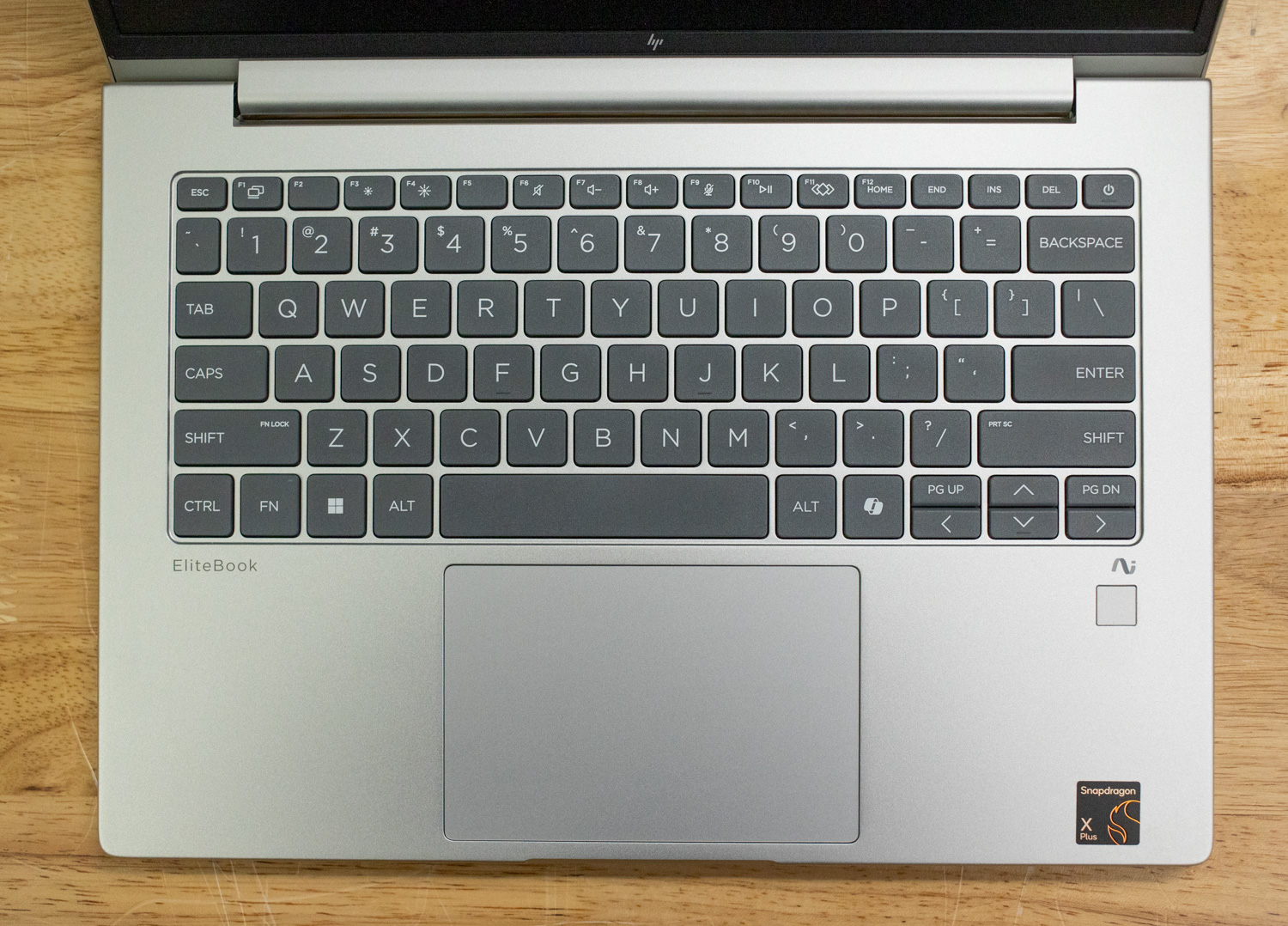




 Amazon
Amazon